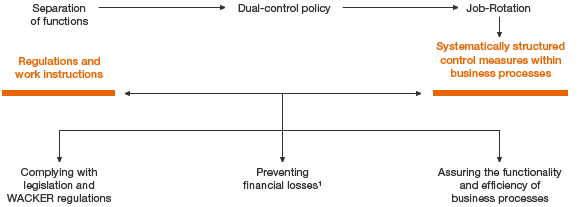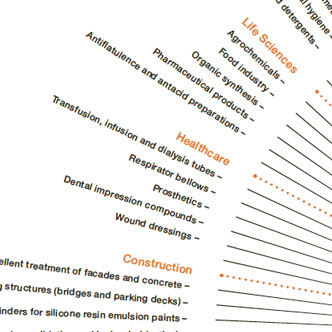Risk Management Structures and Tools
This groupwide system draws on existing organizational and reporting structures, supplemented by additional elements:
- The risk management manual: this contains the system’s principles and processes. It explains reportable levels of risks and how risks are to be covered and mapped.
- The risk management regulation: this stipulates groupwide reporting requirements, including when a specific committee must be informed.
- The risk management coordinator: this coordinator is responsible for the risk management system and is supported by local risk coordinators.
- The risk list: this records each specific risk facing our divisions and other corporate sectors. Reporting is mandatory for individual risks where the effect on earnings would exceed €5 million.
Risk Identification
WACKER identifies risks at two levels: for the individual divisions, and at a Group level. We employ various instruments to ascertain and identify risks. These include order intake development, market and competition analyses, customer talks and ongoing observation and analysis of the economic environment.
Assessment, Quantification and Management of Risks
We analyze each identified risk’s probability of occurrence and potential effects on earnings. Corporate Controlling compiles a monthly report to inform the Executive Board of current and expected business developments and their associated risks. We evaluate and balance risks and opportunities at regular meetings with our divisions.
Corporate Controlling ensures that our risk management standards are implemented and that our risk management process is enhanced. It not only records all substantial risks groupwide, but also evaluates them systematically according to uniform criteria. Major risks and those endangering the continued existence of the company are communicated immediately via ad-hoc reporting. Because the divisions are responsible for their own profit and loss, this process is closely interwoven with operational controlling. Individual divisional risks are identified and evaluated on a monthly basis. Operational risk management is thus firmly anchored in the divisions. At the same time, Corporate Finance and Insurance, Corporate Accounting & Tax, Raw Materials & Energy, Technical Procurement & Logistics, Corporate Engineering, and Legal are involved in risk controlling at the Group level.
Financial risks are managed by Corporate Finance and Insurance, which is responsible for all measures relating to exchange-rate and interest-rate hedging transactions and ensuring adequate Group liquidity. The operational framework is set out in detailed specifications and regulations covering, for example, separation of trading and settlement functions. Corporate Accounting & Tax monitors receivables management vis-à-vis customers.
Risk Management System

Internal Control System (ICS) and Internal Control System for Accounting
Our internal control system (ICS) is an integral component of our risk management system.
Our internal accounting control system is aimed at ensuring consistent compliance with statutory requirements, generally accepted accounting principles and International Financial Reporting Standards (IFRS) – the goal being to avoid misstatements in Group accounting and external reporting.
Basis of Our Internal Control System (ICS)

1 Possible financial losses due to the intentional or inadvertent misconduct of our employees or third parties.
In addition to the ICS principles already mentioned, we perform assessments and analyses to help identify and minimize any risks that may directly influence financial reporting. We continually monitor changes in accounting standards and provide the employees handling them with regular and comprehensive training. We enlist external experts to reduce the risk of accounting misstatements in complex and challenging issues, such as pensions.
Our internal accounting control system is designed to ensure that our accountants process every business transaction promptly, uniformly and correctly and that reliable data on the Group’s earnings, net assets and financial position are available at all times. Our approach here complies with statutory provisions, accounting standards and internal accounting rules. A key accounting regulation is the accounting manual in effect groupwide and available on the WACKER intranet. It specifies binding rules for groupwide accounting and assessment. The Group regulation on accounting contains uniform stipulations for the organizational responsibility of accounting-related topics. Additionally, organizational workflows are defined in our accounting and organizational regulations, and in book-entry instructions. A groupwide calendar of deadlines guarantees the complete and timely processing of financial statements. Corporate Accounting monitors compliance with reporting obligations and deadlines. By separating financial functions between accounting, statement analysis and strategy, we ensure that potential errors are identified prior to finalization of the statements and that accounting standards are complied with.
Our subsidiaries ensure that all regulations are implemented in their local regions. Corporate Accounting assists them and monitors the process. Additionally, country-specific accounting standards exist that must be complied with. The reported data is verified both by automatic system validation, and by reports and analyses. Data is checked for plausibility and then consolidated. We safeguard the effectiveness of controls not only by gathering feedback from employees involved, but also by continually monitoring key financial indicators in our monthly management reports and in system-based test runs. Moreover, regular external audits are carried out, and there are external reviews at year-end and for each quarter.
On a quarterly basis, managers at our divisions, corporate departments and subsidiaries confirm for their areas that all key issues for quarterly and annual financial statements have been reported.
The Supervisory Board is also integrated into the internal control system through the Audit Committee. In particular, the Audit Committee monitors the accounting process, the effectiveness of the internal-control and risk-management systems, and auditing procedures. Moreover, it reviews the documents for Wacker Chemie AG’s separate financial statements and the WACKER Group’s annual and quarterly financial statements and the combined management report for these statements, and discusses them with the Executive Board and the auditors.
We protect all financial systems from misuse with user-authorization systems, data-release policies and access restrictions. Information Technology, a corporate department, carries out regular system backups and maintenance measures to minimize both the risk of data loss and of a breakdown of accounting-related IT systems. However, even with adequate and functioning systems in place, we cannot guarantee that the internal control system will be 100-percent effective.
Compliance Management
WACKER’s ethical principles of corporate management go above and beyond the legal requirements. The compliance management department is responsible for ensuring that these principles and all related legal provisions are observed throughout the company. Training courses on compliance raise employees’ awareness of the relevant risks and convey binding rules of behavior for daily work routines. These aspects are covered by WACKER’s compliance regulation. Employees are instructed to inform their supervisors, the compliance officers, the employee council or their designated HR contacts if they notice any violations.
The Group’s compliance officers are responsible for implementing these rules and regulations, and are on hand to advise employees on all matters relating to compliance. The WACKER Group has 23 compliance officers around the world: in Germany, the USA, China, Taiwan, Japan, India, South Korea, Brazil, Mexico, Singapore, Russia, Norway and the United Arab Emirates. Compliance issues arising in countries not listed here are handled in Germany by the Chief Compliance Officer.
Prevention is a key aspect of the work of compliance officers. They train, inform and advise employees and management on, for example, anti-corruption strategies and measures. In 2016, all the compliance officers met in Munich to discuss how to harmonize WACKER’s global approach to combating legal infringements. The prevention of cybercrime was a further point of focus in the reporting period, as it had been in 2015. For example, a dedicated campaign was launched to raise employee awareness of the risks of cybercrime. In 2016, no major infringements of compliance were identified that were subject to the previously mentioned reporting threshold, where the effect on earnings would exceed €5 million.
Internal Auditing
The third line of defense is provided by WACKER’s Corporate Auditing department, which acts as an independent monitoring body for the Executive Board. This department shares responsibility for effective internal control systems throughout the various operational processes and systems. When setting up an internal control system, the operational units must apply certain principles, such as a policy of dual control. These principles are defined in an internationally valid regulation that explains them in more detail for critical functions.
On behalf of the Executive Board, Corporate Auditing therefore mainly performs regular, process-specific reviews of all relevant functions and corporate units, placing its focus on internal control systems. Audit topics are selected using a risk-driven approach. This takes account of risk management reporting, as well as the reports and information provided by the corporate departments, business divisions and larger joint ventures / associates. The Executive Board supplements and approves the auditing schedule, which is discussed by the Audit Committee as well. If necessary, the schedule is flexibly adjusted during the year to take account of changes in underlying conditions.
In 2016, auditing focused on adherence to environmental legislation in the USA, as well as on sales commissions and discounting, including how they are treated in accounting. Whenever cross-functional business-process audits were conducted at subsidiaries, the checks included aspects of plant safety, such as whether safety training or technical inspections were held. During the reporting period, no major complaints about the proper functioning of the control systems came to light as regards the previously mentioned reporting threshold, where the effect on earnings would exceed €5 million.
Any process-optimization measures derived from the audits are implemented and systematically monitored by the auditing department. It provides the Executive Board and Audit Committee with regular reports on the results and implementation status of the various measures.
External Controls
When auditing our annual financial statements, the external auditor examines our early-warning system for detecting risks. The auditor then reports to the Executive and Supervisory Boards.









